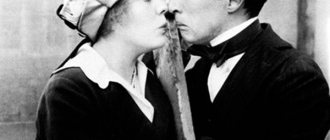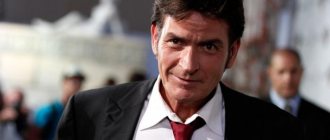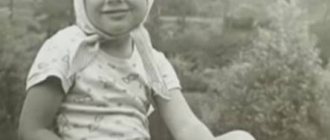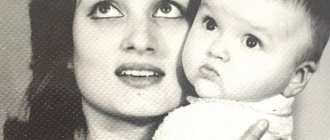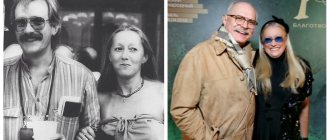Birth and family
Charlie was born late in the evening of April 16, 1889 in the British capital London. This happened on East Lane in the Walworth area, where the Chaplin family of artists lived.
His father, Charles Chaplin Sr., had a pleasant baritone voice and was incredibly popular in the London music halls in the 1880s. He went on tour a lot in European countries, and he also had the opportunity to perform in America. There were also songs in his repertoire that were written personally. But the father of the future great comedian ended his life early and tragically. He drank and died in the spring of 1901 at St. Thomas's Hospital in London while being treated for alcoholism. Chaplin's father was only 37 years old.
His paternal grandmother also died early; baby Charlie was not yet six years old. All he knew about her was that her family had gypsy roots, which Chaplin himself was incredibly proud of all his life.
Charlie's mother, Hannah Chaplin (stage name Lily Gurley) was a variety actress who performed in many London theaters as a dancer and singer. Before her marriage to Charles, Hannah had a relationship with a certain Jew named Hawks, which resulted in the birth of a boy, Sidney Hill. Later, his stepfather gave him his last name, Chaplin. So Charlie had a half-brother on his mother's side, Sydney Chaplin, who also became an actor.
Hard childhood
Charlie Chaplin was born in 1889 in London. His family was very poor. The parents of the future king of comedy were also artists, but they did not gain worldwide fame. My father first tried his hand at pantomime, and later retrained as a “genre singer.” Charlie Chaplin's mother, Hannah Hill, played in the music hall, and her career was also not very brilliant. The life of the actors was unsettled even then, travel and tours were exhausting, and family troubles began. Sydney and Charlie, half-brothers, remained with their mother after their parents' divorce; their father (also named Charles) did not help his ex-wife raise the children, most likely because he simply could not. Hannah left the acting profession, took on any job, but even despite enormous efforts, she was unable to overcome the need. In order for one of the brothers to go to get free food from a charity, he had to wear the only shoes that belonged to his mother. The rest of the family waited patiently for his arrival. They ate once a day. Then Hannah fell ill, was in a mental hospital, and the children, after a period of vagrancy, ended up in a shelter. When the mother was discharged from the hospital (in 1898), their little family was reunited. Charlie Chaplin's work biography began at the age of nine.
The example of his parents did not inspire Charlie with an aversion to the acting profession, although in his life he had the opportunity to try many things. All this experience was later reflected in numerous writing and directing works, but for now the nine-year-old boy danced in the “Eight Lancashire Boys” ensemble, and this lasted for two years. Then Charlie set out at his own risk on a solo voyage through the cruel world of show business: he performed with his own program, performing skits and singing songs. This brought in little money; I had to sell newspapers, teach someone to dance, saw wood, work as a servant, a printer, and even a glass blower.
Childhood
Charlie Chaplin's early childhood years can be called happy. The father was popular, earned enough money, and the young children had no particular needs. But soon Charles Chaplin Sr. found a new love interest and left his family. From then on, hopeless poverty began in the life of little Charlie.
The boy spent all his time with his mother, standing behind the scenes and watching her performances. The baby knew his mother’s entire song repertoire by heart. Thanks to this, at the age of 5 he first appeared on the theater stage, but this happened by chance.
During the number, Charlie stood backstage and listened to his mother sing. Suddenly Lily Gurley coughed and stopped singing. A laryngeal disease had been tormenting her for a long time, and it had to happen to lose her voice during a performance. The rather tipsy audience began to be indignant. And in an instant, five-year-old Charlie had thoughts that now his mother would not be paid and there would be nothing to eat. The kid jumped onto the stage, began to finish singing the song and made funny faces at the same time. The people in the hall were so delighted that they began throwing coins onto the stage. And the boy, without stopping singing, began to collect them, which amused the audience even more.
Her mother’s illness no longer allowed her to go on stage, this caused the poor woman to lose her mind, and she was placed in a clinic for the insane.
In 1896, Charlie was taken in by his own father, but he already had a new family, and the boy lived there for only a short time. At the age of seven, he and his older brother were sent to a workhouse in Lambeth. This is a charitable social institution where those in need were provided with shelter, food and work, but there were no forced obligations.
Early years
In 1898, Chaplin became a member of the children's dance group "Eight Lancashire Boys", the guys gave concerts in which Charlie often got short comic numbers. In 1900, at Christmas the group staged the pantomime “Cinderella”, Chaplin got the role of the cat. The audience liked it, they laughed at his pantomime, but in the spring of 1901 the boy left the group. He began to earn extra money whenever the opportunity presented itself:
- sold newspapers;
- assisted doctors, performing the functions of an orderly;
- worked as a courier in a printing house.
Chaplin did not stay anywhere for a long time and at the same time always dreamed that the day would come when he would make a living as an actor.
At the age of 14, he finally got a permanent place in the theater. Moreover, in the production of Sherlock Holmes he got to play the messenger Billy. However, having reached that age, the guy was practically illiterate. What he was most afraid of when he was given the text of the role was what he would now be asked to read. Thank God, this did not happen, and his older brother Sidney helped him learn the words.
Along with the theater, Charlie performed in variety shows. He got some money, which at the age of 16 he decided to spend on learning to play the violin; he took lessons from a theater conductor.
When Chaplin was 19 years old, his older brother Sidney, who by that time had already established himself as an actor, brought him to Fred Karno's theatrical enterprise. At first Fred did not like the gloomy, short, overly shy young man. After all, the enterprise was based on comedic pantomimes and sketches, what kind of comedian could this Chaplin make? But Charlie revealed his acting talent to Carnot so much that he soon became a leading artist in some productions.
Four wives
Chaplin met his first wife, Mildred Harris, when he was 30 and she was only 16. They got married because Mildred was sure she was pregnant. Although the alarm turned out to be false, very soon Mildred really found herself pregnant and gave birth to a son, who lived only three days. The couple's family life did not work out, and after just two years the couple divorced.
However, Chaplin did not remain alone for long. At 35, he met his future wife, Lita Gray, who was only 12 years old at that time. The actor even asked his friend to paint a portrait of the girl. Their relationship began when Lita turned fifteen and signed a contract to star in a film. Lita quickly became pregnant. Chaplin suggested she have an abortion, but the girl refused. Then he offered to find her a husband and give her “compensation” - $20 thousand, but this option was also rejected. Chaplin could well have gone to prison for having sex with a minor. Gray insisted on the wedding, although she admitted that she did not love Chaplin.
It was decided to get married in Mexico City, in the utmost secrecy. On the way back to California, as Lita stood on the platform of the large windowed carriage, Chaplin approached her and said, “This is a great time to put an end to your disgusting act—why don’t you jump?”
However, this marriage did not last long. Three years later, the couple separated. Gray accused Chaplin of constant infidelity and perversion, and also of pointing a gun at her, insisting on an abortion. At the trial, Lita's lawyer threatened Chaplin to reveal the names of six actresses with whom the comedian slept during his marriage. Gray received $625 thousand after the divorce, as well as $200 thousand for the account of her children.
Chaplin met his third wife a few years later. Most likely, their romance would not have begun if Paulette Goddard had not lied that she was only 17 years old (in fact, she was 22 years old). Very soon she moved in with Chaplin, and they began working on a new film, and soon after the premiere they divorced. Chaplin sought to control life in everything, while Paulette preferred freedom. Although she left the actor, the former spouses remained friends until his death.
At 54, Charlie Chaplin found himself a fourth wife, 18-year-old Oona O'Neill. As happens in a creative environment, she came for a screen test. Although Chaplin thought she was too young for his film, he signed her to a contract and began giving her private acting lessons. The lessons brought him down the aisle again in 1943. Perhaps he has finally found his soulmate, because the couple lived together for 34 years and raised eight children.
America and the beginning of a career
In the fall of 1910, an important event occurred in Chaplin’s life, which turned his entire creative destiny upside down. A multi-deck white liner set sail from the shores of Great Britain to America, and Fred Karnot's theater troupe went on tour to the USA.
At one of the performances, film producer of the Keystone studio Mack Sennett drew attention to Charlie. Chaplin was offered to act in films for $150 a week. For him it was a lot of money, he immediately agreed, opened a bank account into which he deposited his first salary. He adored the film industry, one might even say he raved about it, but at the same time, Chaplin’s dreams for his future life were more mundane; he wanted to buy a small plot in England and start pig farming.
The beginning of his film career did not work out; they even wanted to break the contract with Chaplin, but soon films with his participation began to make a profit.
However, he did not really like the image invented for him - an arrogant swindler and womanizer. Charlie wanted to convey more warmth and lyricism to the viewer. And he came up with a brilliant character - his “little tramp”, who made Charlie Chaplin famous throughout the planet. Wide baggy pants, a tight jacket, a small bowler hat, huge boots, a small mustache and a cane in his hands - in this image he burst into the world of the 20th century film industry.
The audience instantly fell in love with the sophisticated tramp with gentlemanly manners. And Charlie began to understand that he could be not only a successful actor, but also a screenwriter and director, and much more successful and talented than those who filmed him at the Keystone studio. Chaplin left Mack Sennett. And in 1914, the premiere of his first film “Caught in the Rain” took place, where he acted in several guises at once - actor, director and screenwriter.
The last years of Charlie Chaplin's life
However, the actor’s popularity also had a downside.
Over the years he was called an accomplice of communist criminals. For this reason, many of his films were withdrawn from distribution. And Chaplin himself was repeatedly subjected to widespread criticism. The film “The Great Dictator,” in which Chaplin played Hitler, also brought big problems to the actor. The pressure on the actor eased after the German attack on Poland, but many supporters of the fascist party often sent threatening letters to the actor.
Charlie Chaplin had 12 children from different women
In the last ten years of his life, Charlie Chaplin did not act. In his old age, he settled in the Swiss town of Vevey, where he subsequently died quietly in 1977. In the city, which became the comedian’s last refuge, there is a monument to him.
The path from tramp to genius
Charlie's salary began to rise. In 1915, instead of 150 dollars, he was already paid 1,250 weekly at the Essanay Film studio, and in 1916, 10,000 at the Mutual Film studio. In 1917, Charlie signed a contract for $1 million with the First National Pictures studio and acquired the title of the most expensive actor in history. English newspapers then published his photo with a check in his hands and signed: “Charlie Chaplin is the most expensive thing in the world since the World War.”
In 1919, Charlie founded his own film studio, United Artist, all of the films shot there were full-length:
- "Parisian Woman" (1923);
- "Gold Rush" (1925);
- "Circus" (1928);
- "City Lights" (1931);
- "Modern Times" (1936).
Charlie became famous in silent films, and he remained faithful to him even after 1927, when sound films began to be made. He managed to turn crude sketches into a comedy genre and made them an art. Charlie had an amazing gift: he not only had a keen sense of humor and knew how to joke perfectly, he could accurately determine time intervals: how long it would take the audience to laugh at one joke and hear the next one.
Despite his huge income, Chaplin lived for a long time in modest hotel rooms, and kept checks received from the film studio in an old suitcase. And only in 1922 he built his own home in Beverly Hills - a house with forty rooms with a cinema hall and an organ.
Chaplin director
In 1919, Chaplin created his own studio and began producing short films. In 1921, he made his most famous feature film, “The Kid,” about the adventures of a beggar tramp and a little foundling.
Comedy episodes were combined in the film with lyrical ones, the drama of the plot was a harsh social criticism. The film became a milestone both for Chaplin’s work and for all silent cinema.
After shooting his first film, the famous actor and newly minted director, Charlie Chaplin, went on a tour of Europe.
The era of talkies
Silent films brought Chaplin fame, and although sound appeared in films already in 1927, Charlie remained faithful to the old film technology for another decade. Chaplin's first entirely sound film was The Great Dictator, an anti-Hitler film made in 1940. This was the last film to use the tramp Charlie character.
Persecution and departure from the USA
In 1940, Charlie made his first sound film, it was the anti-Hitler film “The Great Dictator.” In this film he appeared as a tramp for the last time.
During World War II, Charlie advocated opening a second front as quickly as possible. In the United States they began to see him as a secret communist and suspect him of anti-American activities. They began to collect an extensive dossier on him.
In 1952, Chaplin went on a world tour with the premiere of his new film Footlights, but he was banned from returning to America.
Charlie went to Switzerland, where he settled in the town of Vevey. Here he wrote music for silent films, published memoirs, on the basis of which the biographical film “Chaplin” was created in 1992. In 1967, he wrote and directed his final film, A Countess from Hong Kong, starring Sophia Loren and Marlon Brando.
In 1941, Chaplin was awarded an Oscar for his performance as “Best Actor” in the film “The Great Dictator.” In 1948, he won the second same award as best screenwriter (the film Monsieur Verdoux). In 1970, his star was laid on the Hollywood Walk of Fame.
In 1972, Charlie was given a limited visa so that he could come to the United States to present an Oscar statuette for his invaluable contribution to the development and history of cinema. The audience gave the great comedian a standing ovation for exactly 12 minutes. In 1975, Queen Elizabeth II awarded Chaplin the Order of the British Empire.
Persecution
After the premiere of the anti-Hitler film “The Great Dictator,” Charlie Chaplin was subjected to serious persecution. He was accused of anti-American activities and adherence to communist ideas.
The FBI took seriously the artist. The peak of persecution came in the 40s, when he presented his next painting, Monsieur Verdoux.
The censors reproached Chaplin for his ingratitude towards America, which sheltered him (he never took American citizenship). In addition, the comedian was called a Jew and a communist.
Charlie Chaplin in the film "The Great Dictator"
Nevertheless, the comedy Monsieur Verdoux was nominated for an Oscar for best screenplay.
Charlie Chaplin was expelled from the United States in 1952, when he was visiting England. As a result, the man settled in the Swiss city of Vevey.
Anticipating that he might be banned from entering America, Chaplin had previously issued a power of attorney for all his property to his wife. As a result, the wife sold all the real estate, after which she and her children came to her husband in Switzerland.
Personal life
Charlie has always been incredibly popular with women.
His first love was the dancer Ketty Halley. They met in London, she was 14, he was 19. There were only five dates in their life, and then he left for America.
In Los Angeles in 1915, Charlie met actress Edna Purviance. Until 1918, they worked together at film studios and were in a loving relationship. In 1918, Edna began an affair with another actor, but Chaplin continued to star her in his films until 1923, and then paid her a weekly allowance until she died in 1958.
In the fall of 1918, the actor entered into a legal marriage with Mildred Harris for the first time. He was 13 years older than the girl. The reason for the wedding turned out to be Mildred's pregnancy, and only later it turned out that it was a lie. In 1919, they finally had a boy, Norman, but three days later the child died. In 1920, Charlie filed for divorce. As he wrote in his memoirs, “he never managed to know the soul of his wife, because Mildred filled her with all sorts of nonsense and pink rags.”
In 1924, Charlie married 16-year-old Lita Gray. They had two boys - Charles Chaplin Jr. and Sidney Earle. During the divorce, Charlie paid his wife a record amount at that time - $825 thousand. Chaplin's biographers agree that his marriage to Lita served as the basis for the plot of Nabokov's novel Lolita.
For a long time, Charlie had a relationship with actress Paulette Goddard. She lived in his house, starred in his films, and after the separation it became known that in 1936 they secretly got married. Paulette was the only woman Charlie with whom they were able to part ways peacefully and maintain friendly relations until the end of their days. As fate would have it, Paulette also spent her last years of life in Switzerland; the woman then married the writer Erich Maria Remarque for the second time.
Charlie's fourth and last wife, Oona Oneal (daughter of a famous writer and Nobel laureate), was 36 years younger than her husband. After the marriage, her father stopped communicating with his daughter. But this union finally turned out to be happy for Chaplin; Una gave birth to three sons (Eugene, Michael and Christopher) and five daughters (Anna-Emile, Josephine, Geraldine, Victoria and Joanna).
Among all Chaplin's children, the famous film actress was his daughter Geraldine and his son Sydney, a theater actor. Granddaughter Oona Chaplin also achieved great success in Spanish cinema.
Charles Chaplin
Contents: Charlie Chaplin – Films – Charlie Chaplin – “Baby” – Charlie Chaplin – “Gold Rush” – “Russian” Charlie Chaplin Charlie Chaplin – Personal life
American and English film director and actor, screenwriter, composer, producer and editor Charles Spencer Chaplin was born on April 16, 1889 in London. His parents, Charles Spencer Chaplin and Hannah Chaplin, were stage actors. Charlie was the youngest child in the family; the eldest son, Sidney Hill, was his half-brother.
Little Charlie first performed on stage at the age of five, replacing his mother, and immediately received a standing ovation from the audience. Hannah lost her voice and could not earn a living; her father left for another family. The children ended up in a workhouse and then in a school for orphans and poor children. In 1898, Charlie joined the children's dance group, the Eight Lancashire Lads. At the age of 14 he got a job in the theater, then began playing in a variety show and learned to play the violin.
In 1908, Chaplin joined Fred Karnot's theatrical enterprise. From September 1910 to June 1912 the troupe toured the USA. In September 1913, the actor entered into a contract with. Although at first Chaplin could not adapt to the film process, he later became a real star and wanted to direct films on his own. The image of the Tramp created by Chaplin made the actor famous. In the 40s, political persecution of the artist began: he was accused of anti-American activities. Since 1952, the actor was banned from entering the country; he settled in Switzerland.
Charles Chaplin died on December 25, 1977, at the age of 89, at his home in Vevey.
Charlie Chaplin – Movies
The image of the Tramp first appeared in films in the film “Children's Car Races” (1914). That same year, Chaplin himself directed, produced and played the lead role in the film Caught in the Rain. In 1919, the artist founded his own film studio, United Artists, together with Mary Pickford, Douglas Fairbanks and David W. Griffith. The first film produced at the studio was the psychological drama “A Woman of Paris” (1923), in which Chaplin appeared in a cameo. It was followed by the widely acclaimed The Gold Rush (1925) and The Circus (1928). Chaplin's first sound film was The Great Dictator (1940), a satire on Adolf Hitler. In 1952, the film “Lights of Footlights” was released, telling about the fate of a creative person. In this film, Chaplin played in tandem with Buster Keaton. Chaplin directed his last film, “The Countess from Hong Kong,” in 1967; the main roles in the film were played by Sophia Loren and Marlon Brando.
Charlie Chaplin - "Baby"
The tragicomedy "The Kid" (1921) became Chaplin's first full-length directorial work. In the story, the Tramp finds a baby in a garbage dump, and after unsuccessful attempts to drop the baby off with a couple, he takes him in for upbringing. Five years later, the grown-up baby (Jackie Coogan) wants to be taken away by the guardianship authorities, and the child’s biological mother, who has become famous, submits a search advertisement to the newspaper. The film became one of Chaplin's most famous works.
Charlie Chaplin - "The Gold Rush"
The adventure comedy about gold miners in Alaska is recognized as one of the two greatest silent comedies along with Buster Keaton's The General. This is Chaplin's only comedy filmed from a pre-prepared script. The film was recognized as a US National Treasure.
"Russian" Charlie Chaplin
Soviet clown Mikhail Rumyantsev, known to many under the pseudonym “Pencil,” received the nickname “Russian Charlie Chaplin.” And this is not surprising, because at the beginning of his career Rumyantsev performed as the Tramp. And although he later abandoned someone else’s role, the style of the American comedian slipped into many skits.
Charlie Chaplin - Personal life
Chaplin was married four times and fathered 12 children. In 1918 he married actress Mildred Harris; the couple divorced in 1920. The artist’s second wife was Lita Gray, who starred in the films “Gold Rush,” “Idle Class,” and “Baby.” The marriage produced Charles Chaplin Jr. and Sidney Earl Chaplin. In 1928, after five years of marriage, Chaplin and Gray divorced. Chaplin entered into a third marriage with actress Paulette Godard - their relationship lasted from 1932 to 1940, and in 1936 they were secretly married. Chaplin's fourth wife, Oona O'Neill, was 36 years his junior. The couple had three sons (Christopher, Eugene and Michael) and five daughters (Geraldine, Josephine, Joanna, Victoria, Anna-Emile). Geraldine became a famous actress, and her daughter Una also continued the acting dynasty: she is known to viewers for her role in the series “Game of Thrones.”
Death
In the autumn of 1977, in the small Swiss town of Vevey, in an old park, every day a tall brunette rolled a wheelchair in front of her, in which sat an elderly man in dark glasses and a hat. His legs were carefully wrapped in a blanket. And no one knew that this 88-year-old man was the Great Tramp, cinematic genius Charlie Chaplin. He was happier these days than ever in his life.
Charlie died in his sleep. This happened on December 25, 1977, he was 88 years old. The actor was buried in the city cemetery of Vevey.
Two months later, vandals removed Charlie's coffin from the grave and stole it to demand and receive a ransom. The villains were detained by the police, and the body was reburied in Corsier-sur-Vevey at the Meruz cemetery. To prevent such abduction attempts, 6 feet of concrete was poured on top.
Life in Switzerland, recent years
After the premiere, the actor and director left the United States with his family, going on a long trip. For five months he looked for a new refuge, not wanting to return to the country of rampant McCarthyism. He chose the Swiss Corsier-sur-Vevey, where he purchased a luxurious estate with a villa. Charlie Chaplin's biography at the final stage is connected with this city; the happy last decades of his life passed here. He became the father of four more children - Eugene, Jane, Annette and Christopher. Many prominent people came to visit the famous actor, the Spanish queen became a frequent guest, artists, writers, and movie stars came here, and the owner of the house greeted them joyfully and hospitably. Una became a wonderful wife and friend for Chaplin; the couple simply exuded happiness and harmony.
Money is only a means of achieving freedom, and, fortunately, Chaplin had plenty of it. In 1957 he completed his penultimate film, A King in New York. It ridiculed many aspects of the American way of life and was initially banned from showing in the United States.
In 1964, Chaplin's autobiographical book was published, which became a bestseller and was translated into many languages.
In 1967, the last picture of the king of cinema was released - “The Countess from Hong Kong”, which was not entirely successful, despite the star cast (Marlon Brando, Sophia Loren and other A-list artists), in which Charlie himself appeared only in an episode. The name of the author alone ensured audience success, but Chaplin decided not to make any more films.
In the end, recognition came in the actor’s second homeland: he was finally appreciated in America, awarding him an Oscar (1972). Chaplin went to the prize presentation ceremony cautiously, preparing for possible incidents, but the delight and applause with which he was greeted by the audience did not raise any doubts about his sincere reverence for his talent. The touched artist showed off a trick with a bowler hat and accepted the honorary award.
For another five years, the king enjoyed fame and wrote scripts, but, in general, led a calm and measured life. He became a knight of the British Empire and received many other honorary titles, which, however, were of little importance given the results of his main cause.
On Catholic Christmas 1977, Charles Spencer Chaplin quietly fell into eternal sleep. His body found peace where he spent his last serene summers - in Corsier-sur-Vevey.
